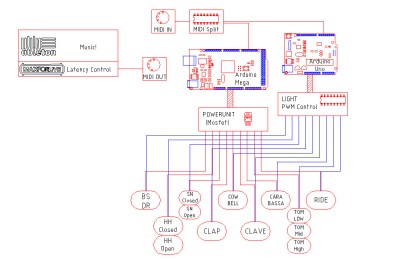If you spent the 1980s hanging out at your local record store, and you don’t have a hankering for spandex and bouffant rock-god hairstyles, the chances are you’ll have more than a few pieces of electronic music from the period in your collection. The proliferation of electronica during that era came through the arrival of relatively inexpensive mass-market digital polyphonic instruments, edging out the sounds of monophonic analog synthesisers for a subsequent generation to rediscover in a later decade. Individual instrument models became icons and entered the musical vernacular of the day, the Ensoniq Mirage sampling synthesiser, the Yamaha DX7 FM synthesiser, or the Roland TR-808 drum machine.
It is the Roland TR-808 that inspired today’s subject, the MR-808 robotic drum machine, from [Moritz Simon Geist]. A percussion sequencer featuring real instruments all built into a cabinet styled to resemble a huge Roland 808. Originally built as a performance instrument, but since reinvented as a piece of installation artwork that visitors can program for themselves.

There is a comprehensive description of the machine’s design and build on the creator’s website, as well as a more high-level introduction. A significant amount of effort was put in to creating mechanical instruments as close as possible to the Roland sounds, with each instrument being operated by solenoids driven by a MIDI-controlled Arduino Mega. A second Arduino, this time an Uno, controls lighting that follows the instruments.
The interactive part of the installation comes from a sequencer front-end running in a web browser on a Nexus 7 tablet, this appears to be served from a Raspberry Pi which supplies MIDI to the MR-808.
The results can be seen in the video below the break, and judging by the reaction of the audience the machine is rather popular.
We’ve featured quite a few vintage Roland synths here at Hackaday. A real Roland 808 received a MIDI interface, and a TB-303 and TR-909 were both the subject of teardowns.
















Gee… what a wasteful design. Why did he not use one arduino per channel and a raspi per arduino to control them.
To keep light and sound independend is some kind of redundance we wanted. Also the µC for the light creates a fading effect (together with the TLC5940) which is kind of big in lines of code. So that why we used two instead of one controller, if that was your question.
This machine was demoed at 33C3 last year, and it is very rad.
So retro; I am smiles.
808
da BOOM baby
Here’s the link to his talk in German. Maybe it has been transcribed by the Video Operations Control of the CCC: https://media.ccc.de/v/29c3-5180-de-en-marvin_und_der_blues_h264
Now do a 303 bass line!
Naa, dis is what is missing…
http://youtube.com/watch?v=1BIgnEiT8ow
P.S.: sorry (not sorry)
yep….
THE most anoying sound in the world….
Just to clarify. You meant the vuvuzela and not the apology (non-apology). Right?
Then you should check out http://www.rayinteractive.org/giant-303
Great idea and very nicely done.
Needs more cowbell.
Lol